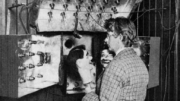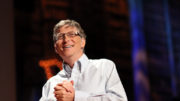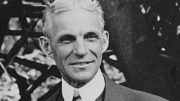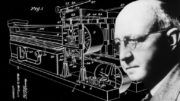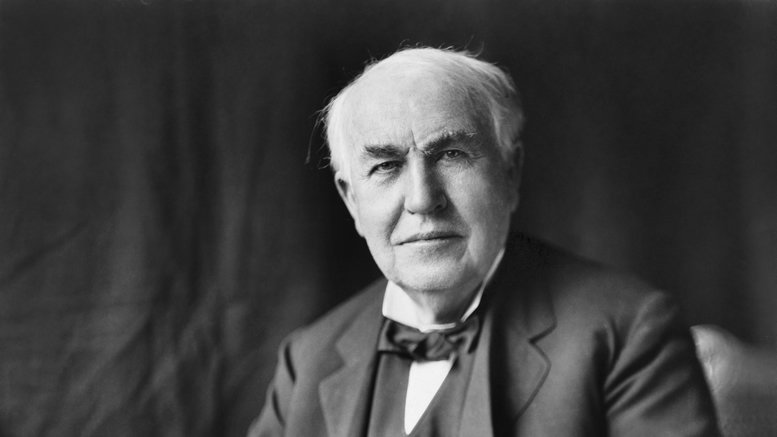 Thomas Alva Edison (February 11, 1847 – October 18, 1931) was a United States inventor and businessman who developed many important devices. “The Wizard of Menlo Park” was one of the first inventors to apply the principles of mass production to the process of invention.
Thomas Alva Edison (February 11, 1847 – October 18, 1931) was a United States inventor and businessman who developed many important devices. “The Wizard of Menlo Park” was one of the first inventors to apply the principles of mass production to the process of invention.
Edison was considered one of the most prolific inventors of his time, holding a record 1,093 patents in his name. Most of these inventions were not completely original but improvements of earlier patents, and were actually made by his numerous employees – Edison was frequently criticized for not sharing the credits. Nevertheless, Edison received patents worldwide, including the United States, United Kingdom, France, and Germany. Edison started the Motion Picture Patents Company, which was a conglomerate of nine major film studios (commonly known as the Edison Trust).
Thomas Edison was born in Milan, Ohio and grew up in Port Huron, Michigan. Partially deaf since adolescence, he became a telegraph operator in the 1860s, and a famously fast one. Some of his earliest inventions related to electrical telegraphy, including a stock ticker.
Edison had worked for a time in his youth selling snacks, and candy on the railroad, laboured as a pig slaughterer and started a business selling vegetables. He could reputedly guess a man’s weight correctly by simply looking at him. Around 1862, Edison printed and published “The Weekly Herald”. It was the first newspaper typeset and printed on a moving train. The Times featured a story on Edison and his paper. Edison applied for his first patent, the electric vote recorder, on October 28, 1868.
Thomas Edison began his career as an inventor in Newark, New Jersey with the stockticker and improved telegraphic devices being invented there, but the invention which first gained Edison wide fame was the phonograph in 1877. While non-reproducable sound recording was first achieved by Leon Scot de Martinville (France, 1857), and others at the time (notably Charles Cros) were contemplating the notion that sound waves might be recorded and reproduced, Edison was the first to produce a device to actually do so, and this was so unexpected by the public at large as to appear almost magical. Edison became known as “The Wizard of Menlo Park” (after the New Jersey town where he resided). His first phonograph recorded on tinfoil cylinders, had low sound quality, and destroyed the track during replay such that one could listen only once. A redesigned model which used wax cylinders was produced soon after by Alexander Graham Bell. Sound quality was still low and replays were limited before wear destroyed the recording, but the invention enjoyed popularity. The “gramophone”, playing disc records was invented by Emile Berliner in 1887; in the early years the audio fidelity was worse than the phonograph cylinders marketed by Edison Records.
Edison’s major innovation was the Menlo Park research lab, which was built in New Jersey. It was the first institution set up with the specific purpose of producing constant technological innovation and improvement. Most of the inventions there carried Edison as the inventor, though he mostly just oversaw the operation of his employees.
Most of Edison’s patents were utility patents, with only about a dozen being design patents. Many of his inventions were not unique, but Edison showed unique skills in winning the patents and beating his opponents by influence and better marketing. For example, Edison did not invent the electric lightbulb. Several designs had already been developed by earlier inventors including Joseph Swan, Henry Woodward, James Bowman Lindsay, William Sawyer and Heinrich Goebel. Edison took the features of these earlier designs and set his workers the task of producing a longer-lasting bulb. After purchasing the Woodward and Evans patent of 1875 Edison’s employees experimented with a large number different materials in order to increase the bulb’s burning time. By 1879 they had achieved the goal of increasing the burning time enough to make the lightbulb commercially viable. Whilst the earlier inventors had produced electric lighting in laboratory conditions, Edison was able to bring lighting to homes and businesses by mass-producing long-lasting lightbulbs and creating a system for the generation and distribution of electricity.
US223898 Electric LampIn 1878, Edison applied the term “filament” to the element of glowing wire carrying an electric current. In 1878, Edison formed Edison Electric Light Company in New York City with financiers (including J.P. Morgan and the Vanderbilts).
Edison wired his lights by parallel circuit, which causes the current to divide among alternative paths. In parallel circuits, the failure of one light bulb does not cause a circuit to fail, which happens to lamps wired in series. On December 31, 1879, Edison demonstrated incandescent lighting to the public for the first time with some fanfare in Menlo Park, New Jersey. On January 27, 1880 he filed a patent in the United States for the electric incandescent lamp. On February 13, 1880, Edison became the first person to observe the Edison effect. On October 8, 1883 the U.S. patent office ruled that Edison’s patent was based on the work of William Sawyer and was invalid.
In 1880, Edison patented electric distribution system. The first investor-owned electric utility was the 1882 Pearl Street Station, New York City. On January 25, 1881, Edison and Alexander Graham Bell formed the Oriental Telephone Company. On September 4, 1882, Edison switched on the world’s first electrical power distribution system, providing 110 volts direct current (DC) to 59 customers in lower Manhattan, around his Pearl Street laboratory. On January 19, 1883 the first standardized electric lighting system employing overhead wires began service in Roselle, New Jersey.
Litigation continued until on October 6, 1889, a judge ruled that Edison’s electric light improvement claim for “a filament of carbon of high resistance” was valid. Research exposed in “A Streak of Luck” by Robert Conot (1979), shows that Edison and his attorneys hid significant information from the judge, they cut out the October 7-21, 1879 section of a notebook. Edison failed to patent the light bulb in the United Kingdom. After losing a court battle with Swan, they formed a joint company (Ediswan) to market the invention. This company and its technological heritage became a part of General Electric in 1892.
Much of the work leading to the improvement of the lightbulb was done by one of Edison’s assistants, Lewis Latimer, an African American.
During the initial years of electricity distribution, Edison’s direct current was the standard for the United States and Edison was not disposed to lose all his patent royalties. During the commonly referred to “War of Currents” era, Serbian immigrant Nikola Tesla and Edison became adversaries due to Edison’s promotion of DC for electric power distribution over the more efficient alternating current advocated by Tesla, who patented AC in Graz, Austria. Edison (or, reportedly, one of his employees) employed the tactics of misusing Tesla’s patents to construct the first electric chair for the state of New York in order to promote the idea that alternating current was deadly. Popular myth has it that Edison invented the electric chair, despite being against capital punishment, solely as a means of impressing the public that alternating current was more dangerous than direct current, and would therefore be the logical choice for electrocutions. In fact, the chair was primarily invented by a few of his employees, in particular Harold P. Brown, working at Menlo Park (though Edison certainly monitored their operations).
Edison went on to carry out a campaign to discourage the use of alternating current, what today would be commonly referred to as FUD. Edison did preside personally over several executions of animals, primarily stray cats and dogs, for the benefit of the press to prove that his system of direct current was safer than that of alternating current. Edison’s series of animal executions peaked with the electrocution of Topsy the Elephant.
Many of Edison’s inventions using direct current ultimately lost to alternating current devices proposed by others: primarily Tesla’s polyphase systems and other contributors, such as Charles Proteus Steinmetz (of General Electric). AC distribution systems replaced DC, enormously extending the range and improving the safety and efficiency of power distribution. Since the 1950s, High Voltage Direct Current (HVDC) transmission systems have become more common in certain situations. HVDC systems are presently used for some specialised applications like the underwater interconnection of Power Systems.
As exemplified by the light bulb story, most of Edison’s inventions were improvements of ideas by others, achieved through a diligent and industrial approach and team-based development. He was the undisputed head of the team which usually did not share credit for the inventions. He himself said: “invention is 1% of inspiration and 99% of transpiration.” Nikola Tesla, possibly Edison’s most famous employee and great scientist in his own right, said about Edison’s method of problem-solving: “If Edison had a needle to find in a haystack, he would proceed at once with the diligence of the bee to examine straw after straw until he found the object of his search. I was a sorry witness of such doings, knowing that a little theory and calculation would have saved him ninety per cent of his labor.”
Initially, it was believed that Thomas Edison invented the motion picture camera, but it has since been proven that William Kennedy Laurie Dickson actually invented it at the Edison laboratories. However, Edison’s influence on the history of film stretches beyond that of instigator. He became a powerhouse of film production and must be given credit for establishing the standard of using 35 mm celluloid film with 4 perforations on the edge of each frame that allowed film to emerge as a mass medium and not just a vaudeville novelty. He built what has been called the first movie studio, the Black Maria in New Jersey. Here he made the first copyrighted film, Fred Ott’s Sneeze.
His inventions benefited people world wide and in 1878, he was appointed Chevalier of the Legion of Honor of France and in 1889 was made Commander of the Legion of Honor.
On September 30, 1890, Edison obtained patent US437422 for telegraphy, US437423, US437424, US437426 for the phonograph, US437425 for a phonograph-recorder, US437427 for a “Method of Making Phonograph Blanks”, US437428 for a “Propelling Device for Electrical Cars”, and US437429 for a phonogram blank.
In 1891, Thomas Edison built a Kinetoscope, or peep-hole viewer. This device was installed in penny arcades where people could watch short, simple films. This was important to Thomas Edison especially because he had been searching for a way to entertain customers that were listening to music on his phonograph. Now, people could go to a penny arcade, put in a coin, put on the headphones and watch a film through the peep-hole.
In West Orange, New Jersey on February 1, 1893 Edison finished construction of “Black Maria”, the first motion picture studio. However, a United States court of appeals ruled on March 10, 1902 that Edison did not invent the movie camera and thus could not exercise monopoly power over its use (see Edison v. American Mutoscope). In 1894, Edison experiments with synchronizing audio with film; the Kinetophone was invented which loosely synchronizes a Kinetoscope image with a cylinder phonograph. In April of 1896, Edison and Thomas Armat’s Vitascope were used to project motion pictures in public screenings in New York City.
Thomas Edison submitted his last patent application, “Holder for Article to be Electroplated”, on January 6, 1931 and died later that year. The patent was granted two years later in 1933.

